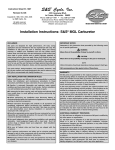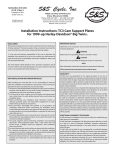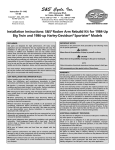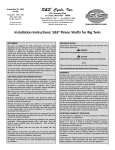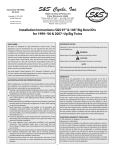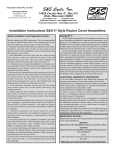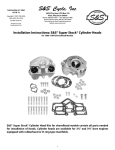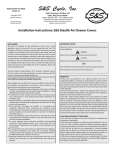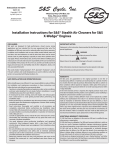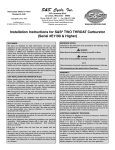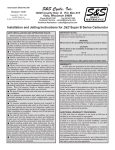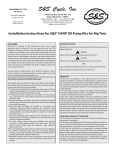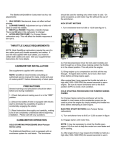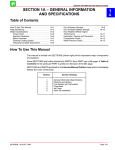Download S&S Cycle, Inc.
Transcript
S&S Cycle, Inc. ® Instruction 51-1196 4-7-06 Copyright © 2001, 2004, 2006 235 Causeway Blvd. La Crosse, Wisconsin 54603 by S&S Cycle, Inc. Phone: 608-627-1497 • Fax: 608-627-1488 All rights reserved. Printed in the U.S.A. Technical Service Phone: 608-627-TECH (8324) Technical Service Email: [email protected] Website: www.sscycle.com Because every industry has a leader Installation Instructions: S&S® Super D Gasoline Carburetor DISCLAIMER: IMPORTANT NOTICE: S&S parts are designed for high performance, off road, racing applications and are intended for the very experienced rider only. The installation of S&S parts may void or adversely effect your factory warranty. In addition such installation and use may violate certain federal, state, and local laws, rules and ordinances as well as other laws when used on motor vehicles used on public highways, especially in states where pollution laws may apply. Always check federal, state, and local laws before modifying your motorcycle. It is the sole and exclusive responsibility of the user to determine the suitability of the product for his or her use, and the user shall assume all legal, personal injury risk and liability and all other obligations, duties, and risks associated therewith. Statements in this instruction sheet preceded by the following words are of special significance. The words Harley®, Harley-Davidson®, H-D®, Sportster®, Evolution®, and all H-D part numbers and model designations are used in reference only. S&S Cycle is not associated with Harley-Davidson, Inc. SAFE INSTALLATION AND OPERATION RULES: Before installing your new S&S part it is your responsibility to read and follow the installation and maintenance procedures in these instructions and follow the basic rules below for your personal safety. ● Gasoline is extremely flammable and explosive under certain conditions and toxic when inhaled. Do not smoke. Perform installation in a well ventilated area away from open flames or sparks. ● If motorcycle has been running, wait until engine and exhaust pipes have cooled down to avoid getting burned before performing any installation steps. ● Before performing any installation steps disconnect battery to eliminate potential sparks and inadvertent engagement of starter while working on electrical components. ● Read instructions thoroughly and carefully so all procedures are completely understood before performing any installation steps. Contact S&S with any questions you may have if any steps are unclear or any abnormalities occur during installation or operation of motorcycle with a S&S part on it. WARNING Means there is the possibility of injury to yourself or others. CAUTION Means there is the possibility of damage to the part or motorcycle. NOTE Other information of particular importance has been placed in italic type. S&S recommends you take special notice of these items. WARRANTY: All S&S parts are guaranteed to the original purchaser to be free of manufacturing defects in materials and workmanship for a period of twelve (12) months from the date of purchase. Merchandise that fails to conform to these conditions will be repaired or replaced at S&S’s option if the parts are returned to us by the purchaser within the 12 month warranty period or within 10 days thereafter. In the event warranty service is required, the original purchaser must call or write S&S immediately with the problem. Some problems can be rectified by a telephone call and need no further course of action. A part that is suspect of being defective must not be replaced by a Dealer without prior authorization from S&S. If it is deemed necessary for S&S to make an evaluation to determine whether the part was defective, a return authorization number must be obtained from S&S. The parts must be packaged properly so as to not cause further damage and be returned prepaid to S&S with a copy of the original invoice of purchase and a detailed letter outlining the nature of the problem, how the part was used and the circumstances at the time of failure. If after an evaluation has been made by S&S and the part was found to be defective, repair, replacement or refund will be granted. ● Consult an appropriate service manual for your motorcycle for correct disassembly and reassembly procedures for any parts that need to be removed to facilitate installation. ADDITIONAL WARRANTY PROVISIONS: ● Use good judgement when performing installation and operating motorcycle. Good judgement begins with a clear head. Don't let alcohol, drugs or fatigue impair your judgement. Start installation when you are fresh. (2) S&S shall have no obligation if an S&S part becomes defective in whole or in part as a result of improper installation, improper maintenance, improper use, abnormal operation, or any other misuse or mistreatment of the S&S part. ● Be sure all federal, state and local laws are obeyed with the installation. ● For optimum performance and safety and to minimize potential damage to carb or other components, use all mounting hardware that is provided and follow all installation instructions. (3) S&S shall not be liable for any consequential or incidental damages resulting from the failure of an S&S part, the breach of any warranties, the failure to deliver, delay in delivery, delivery in non-conforming condition, or for any other breach of contract or duty between S&S and a customer. ● Motorcycle exhaust fumes are toxic and poisonous and must not be inhaled. Run motorcycle in a well ventilated area where fumes can dissipate. (4) S&S parts are designed exclusively for use in Harley-Davidson® and other American v-twin motorcycles. S&S shall have no warranty or liability obligation if an S&S part is used in any other application. (1) S&S shall have no obligation in the event an S&S part is modified by any other person or organization. 1 Carb Only – (1.937-inch venturi) .............................PN 11-0112 Carb Only – (2.150-inch venturi) .............................PN 11-0128 Carb Kit With Air Horn ............................................PN 11-0110 Support Bracket........................................................PN 16-0471 (Recommended for any D Carb installation) CAUTION The heat generated during polishing and chrome plating processes can alter operating tolerances machined into the parts in critical areas. Additionally, pieces of chrome may break off and plug a passageway which could potentially affect the fuel mixture resulting in damage to the engine. S&S voids any warranty if the carb body or bowl has been polished, chrome plated or altered in any way. Throttle Requirements: An S&S Super D carburetor requires the use of a two cable, pull open - pull closed throttle assembly. WARNING Single, braided wire cable throttle mechanisms can not mechanically close the throttle. If your throttle inadvertently sticks in the open position, you could lose control of the motorcycle and personal injury to you or others may result. INSTALLATION The Super D carburetor was designed for racing applications and should be considered a custom installation. A certain amount of fabrication and engineering will be required to adapt this performance carburetor to your motorcycle. It is delivered in a state of basic tune to help you start the motorcycle after installation, but final tuning to match your bike will be required. If you do not feel comfortable with the steps required in this installation, please visit www.sscycle.com or call the S&S® Tech Line at (608) 627-TECH for a recommended shop in your area. NOTE: Installation of S&S Super D carb kits is easier with the gas tank(s) off of the motorcycle. Some owners may elect to perform this installation without removing gas tank(s)--an option left up to the discretion of the technician. 1. IDLE SPEED AND MIXTURE SETTINGS FOR START UP A. Set idle mixture screw setting by turning it clockwise until it is fully closed. Now open the screw (turn counter-clockwise) 11⁄2 turns. See Photo 1. Your S&S Super D carburetor is designed exclusively for large displacement big twin engines. It is a butterfly carb with a fully adjustable idle mixture screw with replaceable mid range and high speed jets. Additionally, it has a tuneable air bleed circuit. It doesn’t have an accelerator pump or a conventional choke, instead it utilizes a mixture enrichment device for starting. The Super D has both a 1.937- and 2.150-inch venturi available—depending on your requirements. Also, the S&S Super D is not recommended for use with a fuel pump. DISCLAIMER: S&S parts are designed for high performance, off road, racing applications and are intended for the very experienced rider only. The installation of S&S parts may void or adversely affect your factory warranty. In addition such installation and use may violate certain federal, state, and local laws rules and ordinances as well as other laws when used on motor vehicles used on public highways, especially in states where pollution laws may apply. Always check federal, state, and local laws before modifying your motorcycle. It is the sole and exclusive responsibility of the user to determine the suitability of the product for his or her use, and the user shall assume all legal, personal injury risk and liability and all other obligations, duties, and risks associated therewith. Chrome Plating the Carburetor NOTE: S&S does not recommend chrome plating the Super D carburetor. In order to achieve a quality chrome finish, polishing and buffing are required. These operations invariably plug air or fuel feed holes, regardless of the precautions taken. 2 Photo 1 CAUTION Use caution closing the idle mixture screw; using too much force can cause permanent damage to the carburetor body. B. Set engine idle speed adjusting screw setting by turning it counterclockwise until there is no contact with carburetor body. Next, turn it clockwise until it makes contact again, and turn one additional 1⁄2 turn to open throttle plate slightly. See Photo 2. WARNING If throttle does not return to fully closed position when released, it may inadvertently stick open possibly causing loss of control of motorcycle and personal injury to you or others. C. 6. Photo 2 2. PREPARE AIR CLEANER BACKPLATE A. The backplate is a custom application based on your motorcycle. Determine your choice of breather (head or case) and drill the backplate accordingly. B. Use of an Air Horn is a custom application based on your motorcycle’s set up. 3. INSTALL NEW MANIFOLD A. Verify that intake ports are clean and ready for installation. B. Position manifold with VOES (if equipped) facing up. Do not tighten bolts at this time. 4. INSTALL CARB A. Position carb on intake manifold using two 3⁄8-16 x 1" socket cap screws provided—do not tighten yet. B. If you are using a backplate and head breathers, now is the time to position them. C. Tighten manifold to heads and then carb to manifold. NOTE: this is easiest with a 6-inch ball-head Allen. D. Remove backing plate for throttle cable installation. CAUTION 1. 2. Apply a thin coat of oil to the fuel inlet fitting and slide the 90° bend portion of the fuel line in place. Slide hose clamp in place and secure. Slip protective fuel line covering over fuel line and position in a way where there will be no contact with other engine parts. Connect other end of the fuel line to petcock using the clamp provided. INSTALL AIR CLEANER BACKPLATE/AIR HORN A. Since this is a custom application, install backing plate according to your design. B. If you are using a filter element and air cleaner cover, install them now. C. Check fuel needle and seat assembly to be sure it works properly. Add enough gas to tank(s) to test the system. Lean the motorcycle over on the carburetor side, turn the fuel supply valve on and wait 20 seconds. If gas starts running out of the carb, turn off petcock and check needle and seat. WARNING Fuel needle and seat assembly must completely shut off the fuel supply entering the float bowl and not leak. Gasoline leaks at the fuel line connections or past the inlet needle may flood engine and overflow on surrounding area creating fire hazard. 7. CARB OPERATION A. This carburetor does not have a conventional choke. Instead, a mixture enrichment device that uses utilizes separate air and fuel pickup passageways aides in starting. B. This device is engaged by raising the lever on top left side of carburetor and rotating it to position. See Photo 3. If you install mounting screws that are too long, they may bottom without fully tightening. Also, they may contact the carb bowl or body causing damage and potential failure. An improperly mounted carburetor could come loose causing air leaks, poor performance, and damage to carburetor or other components. WARNING If your motorcycle were to fall over or sustain damage in a collision, an improperly mounted carburetor could break free causing a release of gasoline to the surrounding area creating a fire hazard and potential personal injury to you or others. 5. ROUTE THROTTLE CABLES A. Since this is a custom application, it is up to you to determine the appropriate length and routing of both cables. B. Ensure that cables do not bind by turning the handlebars full-lock to each side and operating the throttle. It should open smoothly with no resistance and snap shut. Photo 3 3 NOTE: The enrichment pickup tube that is located directly below the fast idle plunger is pressed into carburetor body and must not be removed. CAUTION Removal of enrichment/fast idle pickup tube from the carburetor body may alter its hole size in the main body and cause irreversible damage to carburetor. COLD START 1. Open fuel supply valve. 2. Pull enrichment device handle up. 3. Turn on ignition. 4. With throttle closed or just slightly open, press starter button, cranking for no more than 5 seconds at a time. If engine fails to start immediately, slowly open throttle enough to slightly open the butterfly and crank starter until engine fires. 5. Once the engine starts leave the enrichment device on until engine has warmed. If you feel it is necessary, open throttle slightly to keep the engine running. The actual intermediate jet size installed in your carburetor is indicated on a tag attached or labeled on the box. Keep this information handy for future reference. HOT START 1. Open fuel petcock. 2. Turn on ignition. 3. With throttle closed engage electric starter. 4. If engine fails to start immediately, open throttle slightly and continue to engage starter until the engine fires. 4. ADJUSTING THE IDLE CIRCUIT The idle mixture screw regulates the air/fuel mixture at idle speeds and works in conjunction with the throttle stop/engine rpm adjustment screw that is located on the throttle arm. Your Super D carb is delivered with settings that should work for initial start-up, but will require adjustment and tuning specific to your motorcycle. 1. Start engine and let it run for a few minutes until it is at operating temperature. 2. Initially adjust engine rpm to idle to approximately 950-1000 rpm. 3. Turn the idle mixture screw clockwise--to lean the mixture--until the engine starts to die. Now turn the screw counterclockwise--richening the mixture--until the engine starts to die. Keep track of the distance (number of turns) between the two points and turn it back to the mid-point. Photo 4 1. 2. 3. 5. 6. Run the bike enough for the engine and oil to reach normal operating temperature. Verify idle mixture settings again. Go on a road test to check carburetion characteristics. Maintain a steady speed of 30-, 40- and 50-mph. Once you set your speed, if you feel or hear popping or backfiring in the aircleaner, the bike is too lean. Correct this by installing the next larger jet size in the kit. If the bike accelerates sluggishly or you notice black smoke from the exhaust, the jetting is too rich. Correct this by installing the next smaller size jet in the kit. Repeat the road test procedure. The smallest intermediate jet that eliminates the popping and provides the best throttle response should also provide the best fuel economy. Adjust idle circuit as necessary. MAIN JET/HIGH SPEED CIRCUIT The high speed circuit—controlled by the main jet--begins around 3000-3500 rpm or 55-60 mph and runs to your motorcycle’s maximum speed. You can access the main jet by removing the float bowl plug. See Photo 5. NOTE: Whenever intermediate jet change is made, idle mixture screw must be readjusted. INTERMEDIATE CIRCUIT The intermediate range is used in most normal riding conditions, beginning right off idle and going up until 30003500 rpm depending on the gearing in your motorcycle. For that reason, you must pay close attention to jetting your intermediate circuit to achieve optimum performance and best gas mileage. You can access the intermediate jet by removing the float bowl assembly. Photo 4 4 Photo 5 The actual main jet size installed in your carburetor is indicated on a tag attached or labeled on the box. Keep this information handy for future reference. Determining your main jet size is best determined at a drag strip because maximum miles per hour and rpm are the best indicators of the actual horsepower your engine is developing. A dyno will help you get a good baseline, but the drag strip will assure you the best performance of your racing carburetor. NOTE: S&S® has a special main jet tool, PN 53-0452, which is JETTING SIZES perfect for this operation. DRAGSTRIP PROCEDURE 1. Warm up engine enough to make a pass. 2. Make a run noting engine rpm and top speed. 3. Richen main jet size .004 larger and make a second run. Again, note rpm and final speed. 4. Continue procedure until top speed starts to fall. 5. Lean main jet size by .002 to gain the best performance from the last pass. When you are making runs, do not be concerned with elapsed time, rather with consistent miles per hour. STREET PROCEDURE S&S uses what we call the RPMing method to determine your correct main jet size on the street. By performing hard acceleration tests, noting rpm at which power starts to fall off and a gear change is necessary, you will determine what jet offers the best performance. 1. Warm engine to operating temperature. 2. Accelerate rapidly through the gears noting how quickly--and smoothly—your engine reaches an rpm level where power starts to fall off and a gear change becomes necessary. 3. If the engine backfires in carburetor, breaks up or dies during acceleration, richen the main jet size .004 larger and road test it again. 4. If engine runs sluggish or will not take throttle, lean the main jet size by .004 smaller and road test again. Note your engine’s smoothness and how easily it accelerates to shift points. 5. Determine the best jet size by matching up acceleration feel to an rpm level that continues to produce power as you change into the next gear. ADJUSTABLE AIR BLEED The main air bleed passage in an S&S Super D carburetor is equipped with a .040" jet. By allowing the jet size to be changed you can fine tune the transition from intermediate circuit to the main jet to match your motorcycle. Changing the air bleed jet should only be done after you are absolutely sure that you cannot tune a rideability problem out by changing the intermediate and main jets. Shifting the start of the main jet’s operation higher up the rpm scale can lessen the effects of mid-range problems created by mismatched cam and pipe combinations. See Photo 6. Typical Jetting 124 SSW + .032 Intermediate .098 Main .040 Air Bleed 145 SSW+ .032 Intermediate .102 Main .040 Air Bleed NOTE: A number of racing combinations have allowed the use of up to a .120 Air Bleed. NOTES: General Information 1. Carburetor body has seven drilled passages that are permanently sealed with drive plugs. Do not attempt to remove these plugs as irreversible damage to carburetor may result. 2. If the throttle arm is removed from it’s shaft, it must be reinstalled in wide open position with throttle plate at 90˚ to the fully closed position. 3. The throttle plate should be checked annually for signs of wear. Replace if necessary. 4. To insure proper seal in needle and seat assembly, float hinge, needle lift and needle must work freely and must not bind. If problem is suspected, remove bowl and check float movement. If obvious misalignment, binding or sticking occurs, remove and straighten and reinstall to attain free movement. Reset float level and double check for free movement. Float must not contact bowl gasket. 5. Normal float setting is 1⁄32" and should be measured at end of float opposite needle and seat assembly. To check this measurement, turn bowl upside down and measure from bowl gasket surface up to float. 6. On rubber mounted engines, set float where it just misses bowl gasket, S&S PN 11-2086, when fuel inlet needle is fully closed and spring in needle is compressed. See Figure 1. To check, remove bowl and raise float until needle is in closed position and spring in top of needle is compressed. Highest part of float should be slightly (approximately 1⁄32") below bowl gasket surface. Float must not contact bowl gasket. Float just below gasket surface (approximately 1/32”) Spring in needle fully compressed Figure 1 Photo 6 5 Replacement Parts for S&S® Super D Gas and Alcohol Carburetors 1. Carb body assembly 21⁄4" Super D gas .......................................................11-2181 21. Carb bowl assembly 2 1⁄4" Super D gas - forked mechanism .........................N/A 2. Throttle shaft - includes throttle plate screws .....11-2184 (Must use bowl, float, and needle w/wire type mechanism.) 3. Throttle plate screw (5 Pack) ...................................50-0064 2 1⁄4" Super D gas - wire mechanism .......................11-2188 4. Throttle shaft bushing - for repair only............... 11-2134 22. Bowl plug (5 Pack) ....................................................11-2092 5. Throttle plate all - 21⁄4" D carbs...............................11-2150 23. Needle - 21⁄4" Super D gas 6. Throttle return spring (5 Pack).............................. 11-3500 Forked mechanism...................................................11-2095 7. Throttle arm assembly 21⁄4" Super D gas/alcohol......................................... 11-2148 Wire mechanism.......................................................11-2197 8. Idle mixture screw (5 Pack) .......................................11-2378 9. Idle mixture screw spring (10 Pack)..........................11-2060 10. Manifold O-ring .......................................................50-8014 24. Seat - 21⁄4" Super D gas Forked mechanism .160" I.D...................................11-2065 Wire mechanism .238" I.D. .....................................11-2165 25. Needle & seat assembly fuel/alcohol 11. Insulator block 21⁄4" x 1⁄4" includes O-ring...............16-0499 Carbs with forked float mechanism ............................ N/A 12. Enrichment device....................................................11-2084 Carbs with wire float mechanism ........................11-2130 13. Bowl vent plug (10 Pack) ...........................................50-0151 14. Main discharge tube 2 1⁄4" Super D gasoline...............................................11-2185 15. Main jet/main discharge air bleed State size - see jets in fuel system section Not Shown: 26. 1" Spacer block, Super D.........................................16-0157 27. Air horn 4 1⁄4" long ....................................................17-0141 16. Intermediate jet- State size - See jets in race section. 28. Air cleaner, Super D .................................................17-0198 17. Bowl gasket - 21⁄4" Super D gas/alcohol (5 Pack) ...11-2092 29. Fuel line 1⁄4" ID w/90° bend,19" ..............................19-0475 18. Float All carbs with forked mechanism ................................ N/A All carbs with wire mechanism ..............................11-2187 19. Float retaining pin 21⁄4" Super D gas/alcohol ........11-2069 20. Bowl screw 10-24 x 3⁄4" (10 Pack)...............................50-0063 Super D Gas Carburetor Years Produced - 1983-up Size Produced - 21⁄4" Throat Identification Markings: ● Serial number stamped on body above "S&S Super". ● "D" and "181" cast on body below "S&S Super". Distinguishing Characteristics: 6 ● Enrichment starting system. ● Donut shaped float. ● .235" I.D. fuel inlet. ● Bowl vented out air cleaner end of carb. ● Designed for two throttle cables–air cleaner/air horn mounting pattern different from stock. 12 3 6 8 10 2 9 4 15 10 5 13 11 7 1 14 16 15 17 18 18 19 21 20 23 22 23 24 24 7 Because every industry has a leader








